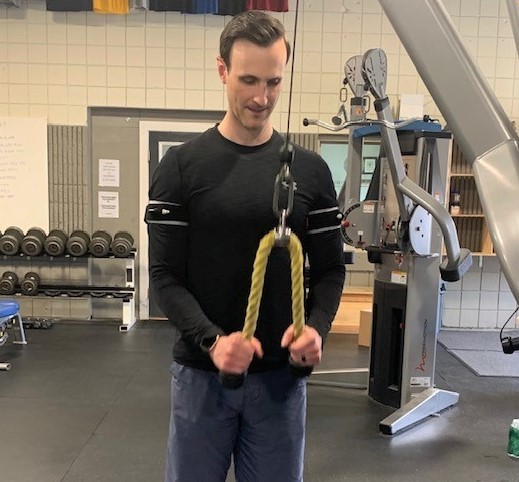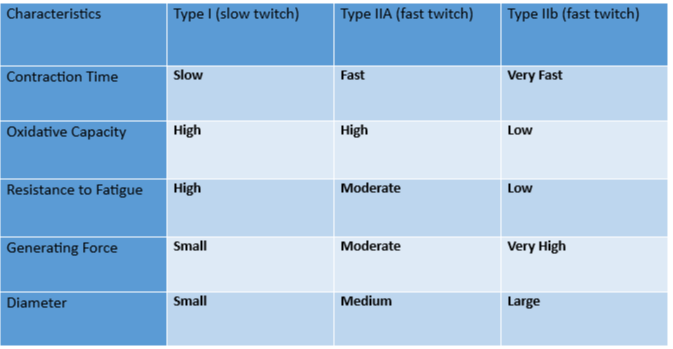August 15, 2021
What is blood flow restriction (BFR) training
BFR is a method of training that requires the participant to wear specialty bands around their proximal arms or legs while exercising. The bands restrict blood flow in and out of the muscles, which is proposed to cause a cascade of chemical changes that essentially trick the body into thinking it is exercising at a higher loads/intensities. Why would this be of benefit you might ask. Well, good questions. BFR training allow the participant to train with significantly lower loads, and lower volume, but allows them to achieve similar benefits of training with the high load and high volume. This is can be used across many different landscapes, but we will focus on the rehabilitation sector in this blog. The use of BFR allows our therapists to train our patients who may be dealing with pain, or post-surgical rehab that does not allow them to perform strenuous training.
How does BFR work
As stated above, the participant wears specialty bands as high up on their arms or legs as possible.  The bands create restriction to this area, which reduces blood flow in and out of the muscle. It is very important to note that you do not want to completely occlude blood flow while exercising, as this can lead to serious injury. Hence, why we use specialty bands that have been designed and studied to only restrict blood flow. The reduced blood flow into the muscles, reduced the delivery of oxygen (O2), which is a large fuel source of our slow twitch (type 1b) muscle fibers. The restriction also leads to a build-up of metabolites, lactate, and hydrogen ions (H+) in the muscles, which causes the blood pH levels to drop. The decrease in blood pH is proposed to trigger a chemical reaction, which eventually initiates muscle repair. Once the bands are released, there is a surge of blood flow back into the muscles, which is thought to account for cellular swelling. Let’s look further into each mechanism. If the pathophysiology isn’t your cup of tea, I recommend skipping to the bottom.
The bands create restriction to this area, which reduces blood flow in and out of the muscle. It is very important to note that you do not want to completely occlude blood flow while exercising, as this can lead to serious injury. Hence, why we use specialty bands that have been designed and studied to only restrict blood flow. The reduced blood flow into the muscles, reduced the delivery of oxygen (O2), which is a large fuel source of our slow twitch (type 1b) muscle fibers. The restriction also leads to a build-up of metabolites, lactate, and hydrogen ions (H+) in the muscles, which causes the blood pH levels to drop. The decrease in blood pH is proposed to trigger a chemical reaction, which eventually initiates muscle repair. Once the bands are released, there is a surge of blood flow back into the muscles, which is thought to account for cellular swelling. Let’s look further into each mechanism. If the pathophysiology isn’t your cup of tea, I recommend skipping to the bottom.
To understand how reduced O2 can effect muscle recruitment, we first need to have an understanding of the different types of muscle fibers and how they are recruited. There are two types of muscle fibers, slow twitch (type I) and fast twitch (type IIa and IIb) muscle fibers. Slow twitch muscle fibers are used for more endurance-based activities (i.e. long distance running, swimming, power walking); whereas fast twitch muscle fibers are used for more explosive movements (i.e. jumping, sprinting, power lifting). The chart below outlines the differences between the muscle fibers. The two main differences that we want to focus on is the muscle fiber size and oxidative capacity. When we start to perform an activity, our bodies recruit the smaller muscle fibers first, which are the slow twitch type I. As we increased the load or intensity of the exercise, our bodies naturally start to recruit the bigger muscle fibers, type IIa and IIb, to help complete the given task.
Type Ia muscles are aerobic, using O2 to create the energy needed to contract. So, it stands to reason that if we reduce the blood supply/O2 flowing into the muscle while we are exercising, the type Ia muscle fibers will fatigue quickly, which leads the body to recruit type IIa/IIb muscle fibers. Type IIb muscle fibers create energy anaerobically, without the use of O2. As we continue to exercise in this state, we need to recruit more type IIb muscle fibers to complete our task. Type IIb muscle fibers are most adaptable to hypertrophy, and strength gains.
 Another proposed mechanism of increasing muscle synthesis occurs from the chemical reaction within the muscle. As the blood flowing in to the muscle is reduced, so is part of our fuel source, O2. As type IIa and IIb muscle fibers are recruited, the body changes how it creates the energy needed for muscle contraction. It now uses the anaerobic (without O2) glycolytic system, which generates lactate and hydrogen ions ( H+). The blood flowing out of the muscle is also reduced, leading to increased H+ concentration and a decrease in the blood pH levels. The drop in blood pH is proposed to trigger a few difference chemical reactions, that ultimately lead to protein synthesis, which helps to repair and build stronger muscles.
Another proposed mechanism of increasing muscle synthesis occurs from the chemical reaction within the muscle. As the blood flowing in to the muscle is reduced, so is part of our fuel source, O2. As type IIa and IIb muscle fibers are recruited, the body changes how it creates the energy needed for muscle contraction. It now uses the anaerobic (without O2) glycolytic system, which generates lactate and hydrogen ions ( H+). The blood flowing out of the muscle is also reduced, leading to increased H+ concentration and a decrease in the blood pH levels. The drop in blood pH is proposed to trigger a few difference chemical reactions, that ultimately lead to protein synthesis, which helps to repair and build stronger muscles.
Finally, when we release the bands after our routine is completed, there is a surge of blood flow, reactive hyperemia. This surge brings nutrients and hormones into the muscles. This is thought to create an increased pressure in the muscle fibers/intercellular space. The increased pressure triggers the cells to initiate protein production to reinforce the cell walls.
How is BFR helpful
As discussed above, BFR allows the participant to exercise at reduced loads and volume, but still receive the benefits one would get working at higher loads and higher volumes. BFR has been shown to generate similar muscle recruitment and growth at 20-30% of one repetition maximum (RM), compared to working at 70-80% of one RM. One RM means the maximum amount of weight someone could lift for one repetition. Being able to reduce the loads this drastically, allows our patients to perform pain-free exercises, while still getting the same benefits from high load/high volume exercise. There is also the added benefit of using BFR without any load. If a patient has post-surgical precautions that does not allow them to load a limb, BFR can be used to induce the same response without load.
BFR is also a modality that can be used more frequently than high load/high volume training. When we perform high load/high volume training, we create muscle damage. When our bodies repair the muscles, they build them bigger and stronger to adapt to the loads we just inflicted on them. However, this can lead to soreness, often called delayed onset muscle soreness (DOMS). Using BFR allows significantly lower loads and volume, which creates significantly less muscle damage and less DOMS. This allows our patients to performs our specific exercises more regularly.
The above mentioned chemical reactions that help increase muscle strength do not just occur within one muscle. It has been shown to be a system wide effect, which can help other muscles, tendons and bone heal. This leads to improved and faster recovery times.
Is BFR Safe
BFR originated in Japan in 1966, and has been used and studied extensively over that time. It has been more widely adopted and used by professional sports and rehabilitation specialist around the world in the subsequent years. BFR has been shown to be a safe and effective modality for the treatment of musculoskeletal disorders. Our therapists perform an extensive evaluation of all patients, and determine if they would be appropriate to use our BFR system. If you have any questions about BFR please contact our office at 207-828-4455, info@pptmaine.com.
Citations
Loenneke, J. P., Abe, T., Wilson, J. M., Ugrinowitsch, C., & Bemben, M. G. (2012). Blood flow restriction: How does it work? Frontiers in Physiology, 3. https://doi.org/10.3389/fphys.2012.00392
Loenneke, J. P., Wilson, J. M., Wilson, G. J., Pujol, T. J., & Bemben, M. G. (2011). Potential safety issues with blood flow restriction training. Scandinavian Journal of Medicine & Science in Sports, 21(4), 510–518. https://doi.org/10.1111/j.1600-0838.2010.01290.x
Pearson, S. J., & Hussain, S. R. (2014). A review on the mechanisms of blood-flow restriction resistance training-induced muscle hypertrophy. Sports Medicine, 45(2), 187–200. https://doi.org/10.1007/s40279-014-0264-9
Takarada, Y. U. D. A. I., Takazawa, H. A. R. U. O., & Ishii, N. A. O. K. A. T. A. (2000). Applications of vascular occlusion diminish disuse atrophy of knee extensor muscles. Medicine and Science in Sports and Exercise, 32(12), 2035–2039. https://doi.org/10.1097/00005768-200012000-00011
Author: Brandon Freeman, PT, DPT



